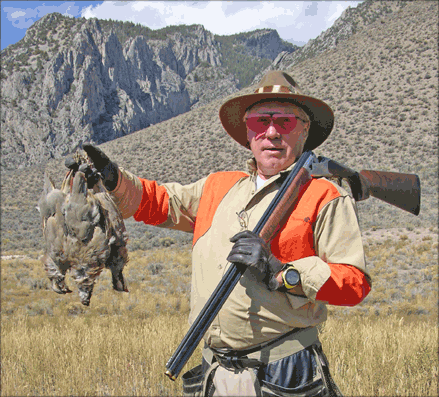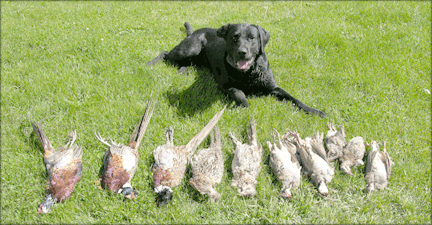Proven: The Superior Stopping Power of RST’s Low-Pressure Shells
Most shooters aren’t aware there is another shotshell manufacturer out there aside from the big four here in the United States. It’s RST and its has been around for a number of years. Their shotshells are manufactured in Friendsville, Pennsylvania, so they are not imported.
Their real specialty is producing shotshells for owners of vintage shotguns or Damascus barrel shotguns that can’t take the high pressures of today’s high-production competition and hunting ammunition. But there is another benefit to RST’s ammunition: very low recoil. If you are getting someone started in competitive shooting or hunting who has a hard time dealing with recoil, RST is the ammunition to use.
RST makes a complete line of shotshells in 10 gauge, 12 gauge, 16 gauge, 20 gauge and 28 gauge. They produce shells in both plastic and paper and in lengths of 2 7/8 inch, 2¾ inch, 2½ inch and 2 inch. RST manufacturers the shells with lead, copper-plated and non-toxic shot. They make shells for competitive shooting and for hunting. They also do custom loading and labeling of shotshells for other firms like shooting schools, and hunting destinations.
There are a lot of old, beautiful turn-of-the-century shotguns out there from Ferlach, Austria and other European makers that have the shorter chambers of 2½ or 2 inches that find that RST shells are well-suited for them. Here is the company that will allow you to enjoy those older firearms for clay target shooting or hunting without the worry of doing damage to your prized possession.
RST had recently sent me a large selection of their shotshells for both target shooting and hunting. They sent shells in the three gauges I had guns in: 12, 20 and 28 gauges. When I opened the flats I noticed the shell boxes were made of a good, sturdy cardboard that would not tear or rip open easily like some imported shell boxes do. Nor did they have to tape the shells boxes closed to keep the shells from coming out. The boxes were printed with all the necessary information you would want to know and was clearly visible.

The shotshells were of excellent quality workmanship from the pure brass base, the properly seated primers, through the high-quality Reifenhauser hulls with plastic base wads and excellent looking crimps. The hulls were stamped with information you could actually read and was very clear and sharp on both the paper and plastic hulls. RST’s shells exuded quality in every respect.
The real fun was going to be in the testing of the shells to see how they would pattern, turn targets into smoke and drop game birds. The first time I went out to the club to shoot some sporting clays and five-stand I tried their 12-gauge loads on the sporting course. They broke targets with authority even out to 60 yards with #8s. These were shotshells at only 1 ounce of shot at 1,125 FPS. I was impressed with their ability to crush targets. Shooting these shells felt more like shooting a .410 or 28-gauge gun.
Then I decided to go to the other end of the spectrum and shoot some 28 gauge at the same targets. There was a teal-like presentation at 55 yards that I creamed consistently with only 5/8 ounce of shot at 1,175 FPS in #8s in the shell. The ¾-ounce loads did the same thing. Needless to say, the shells preformed as well as any other shells out there and with less felt recoil. Everything about these shells has been impressive from the packaging down to the performance of the shells themselves.
The next test was going to be hunting upland birds with these shells. The gun I used for the 20- and 28-gauge shells is a Rizzini Verona Competition 20/28 combo over/under with 30-inch barrels. The reason I choose that gun is that it has exactly the same sight picture as my Browning competion guns, but is about three quarters of a pound lighter, which is a little easier than carrying an eight-pound-plus gun all day. Although the wood is very nice on the gun, it’s not as expensive as on the Browning’s so I wouldn’t feel as bad if it got scratched or damaged.
My first outing was a place about 15 minutes from my house at a place called Tex Creek Wildlife Management Area, which is administered by Idaho Fish & Game. I went out for some chuckars with a friend who had two good dogs.
After covering a lot of ground for almost two hours the dogs flushed a covey of about a dozen birds. We both got a bird out of the flush. I shot mine with a 20 gauge with 7/8 ounce of #7½ shot, and John was using the same shell but with #8s. They were the Lite version at 1,125 FPS. We both shot at about the same time and we agreed the birds were about 40 yards out. We watched where they landed and hit them one more time. We both ended up getting two birds on the second flush. The first ones were pretty close and the second birds were taken at about the same distance as the first two birds, maybe a few yards closer. The birds were hit hard, they were dead before they hit the ground. There was no fluttering around on the ground. We made a sweep back to the truck and didn’t see anything.
After relaxing for a little bit and having some refreshments we headed out again. The terrain was a little more difficult and a little steeper. In no time the dogs flushed a covey and we were a lot closer, and John got one and I got two. Again, when the birds hit the ground, they didn’t move. I was impressed since chuckars are normally harder to kill than pheasants. We spent a few more hours looking for birds and didn’t see anything else. We decided to call it a day.

A couple of days later I went out to a friend’s ranch around Mackay, Idaho. It’s just 90 minutes west of Idaho Falls on Highway 93 north of Arco, and it offers some of the best bird hunting close to town. It’s a beautiful setting nestled at the base of the Lost River Range snow capped mountains.
We started out for pheasant and in about two hours, I had four birds. As we were standing atop a berm and talking about the geology for several minutes, there was a commotion behind us and to our surprise the black lab had kicked up three cocks about 25 to 30 yards from us. I dropped the last departing bird with my 28-gauge load, which filled me out. The shells were RST Lite 28 gauge at 1,100 FPS with ¾ ounce of #6 shot. A couple of the other pheasant were taken with #7½ shot. The shells had the power to put down the pheasant even at 1,100 FPS. I was impressed with their knock-down power given the lower pressures and speeds.

After some refreshments we headed out for some chukars in the foothills. It wasn’t long before we were into a covey. The birds were faster and a little harder to hit, but they normally went down with a single shot. There was one that was a straight away and it took two shots to bring down. We found five different coveys with a little effort. Of the seven chukars taken, all were wild birds although three of them were a little small. The planted birds are all banded so it’s easy to distinguish between the two. There were hundreds of other chukars there waiting to be taken. After four hours of hunting, I had both bags filled. It was a pleasant half-day of hunting in wonderful surroundings.
The RST shotshells did their intended job well and I’d highly recommend them for anyone wanting low-recoil loads or someone wanting to shoot shells safely in their Damascus barrel guns either for target shooting or hunting.
Jerry Sinkovec is a freelance outdoor and travel photojournalist who writes for over 45 different publications nationally and internationally. Jerry is also designing shooting clothing and accessories for Wild Hare Intl. He is the shooting and travel editor for Outdoors Now. He is also the director of the Instinctive Target Interception Shotgun Shooting School headquartered in Idaho Falls, Idaho. He has been teaching for the last 20 years, and has been endorsed by Browning in Utah. He conducts classes in all the western states. His address is: I. T. I. Shotgun Shooting School, 5045 Brennan Bend, Idaho Falls, ID 83401. He can be reached at: 208-523-1545, or online at itishooting@msn.com or http://www.itishooting.com.
Helpful resources:
{loadposition signup}

Jerry Sinkovec is a freelance outdoor and travel writer/photographer who writes for over 45 different publications nationally and internationally. He is also the director of the Browning-endorsed Instinctive Target Interception Shotgun Shooting School headquartered in Idaho Falls, Idaho. You can contact Jerry Sinkovec by visiting his web site at http://www.itishooting.com.


Comments